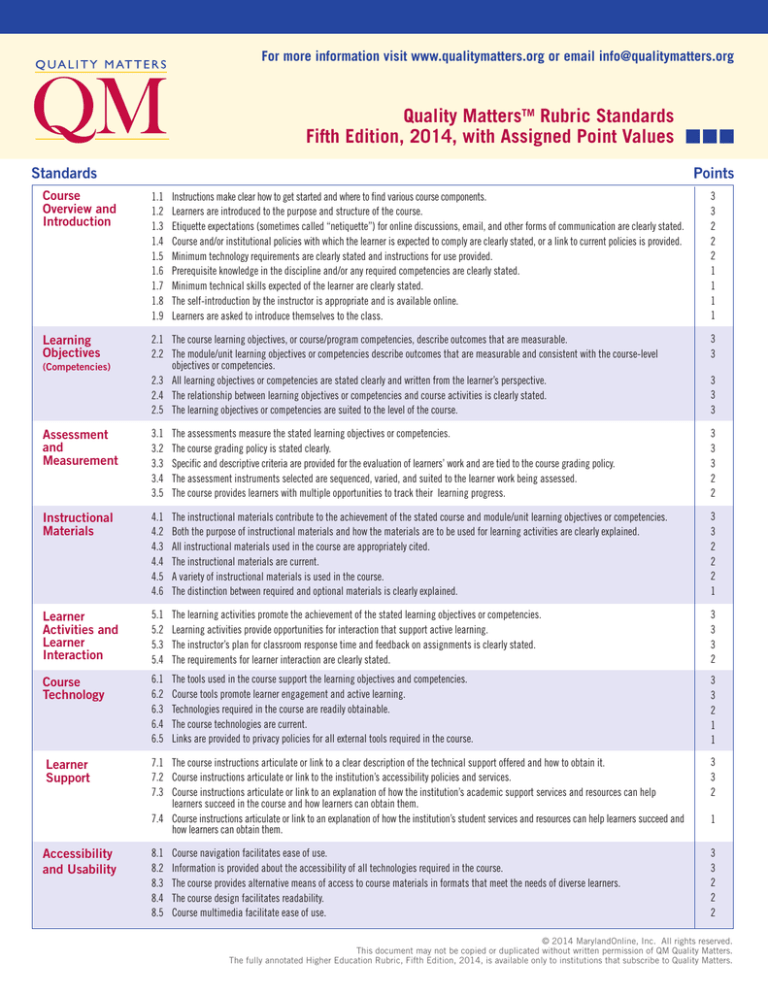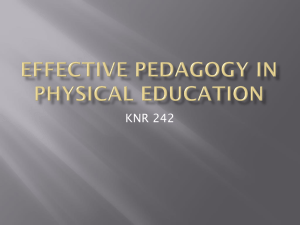
For more information visit www.qualitymatters.org or email info@qualitymatters.org
Quality MattersTM Rubric Standards
Fifth Edition, 2014, with Assigned Point Values
Standards
Points
Course
Overview and
Introduction
1.1
1.2
1.3
1.4
1.5
1.6
1.7
1.8
1.9
Learning
Objectives
2.1 The course learning objectives, or course/program competencies, describe outcomes that are measurable.
2.2 The module/unit learning objectives or competencies describe outcomes that are measurable and consistent with the course-level
objectives or competencies.
2.3 All learning objectives or competencies are stated clearly and written from the learner’s perspective.
2.4 The relationship between learning objectives or competencies and course activities is clearly stated.
2.5 The learning objectives or competencies are suited to the level of the course.
3
3
Assessment
and
Measurement
3.1
3.2
3.3
3.4
3.5
The assessments measure the stated learning objectives or competencies.
The course grading policy is stated clearly.
Specific and descriptive criteria are provided for the evaluation of learners’ work and are tied to the course grading policy.
The assessment instruments selected are sequenced, varied, and suited to the learner work being assessed.
The course provides learners with multiple opportunities to track their learning progress.
3
3
3
2
2
Instructional
Materials
4.1
4.2
4.3
4.4
4.5
4.6
The instructional materials contribute to the achievement of the stated course and module/unit learning objectives or competencies.
Both the purpose of instructional materials and how the materials are to be used for learning activities are clearly explained.
All instructional materials used in the course are appropriately cited.
The instructional materials are current.
A variety of instructional materials is used in the course.
The distinction between required and optional materials is clearly explained.
3
3
2
2
2
1
Learner
Activities and
Learner
Interaction
5.1
5.2
5.3
5.4
The learning activities promote the achievement of the stated learning objectives or competencies.
Learning activities provide opportunities for interaction that support active learning.
The instructor’s plan for classroom response time and feedback on assignments is clearly stated.
The requirements for learner interaction are clearly stated.
3
3
3
2
Course
Technology
6.1
6.2
6.3
6.4
6.5
The tools used in the course support the learning objectives and competencies.
Course tools promote learner engagement and active learning.
Technologies required in the course are readily obtainable.
The course technologies are current.
Links are provided to privacy policies for all external tools required in the course.
3
3
2
1
1
Learner
Support
7.1 The course instructions articulate or link to a clear description of the technical support offered and how to obtain it.
7.2 Course instructions articulate or link to the institution’s accessibility policies and services.
7.3 Course instructions articulate or link to an explanation of how the institution’s academic support services and resources can help
learners succeed in the course and how learners can obtain them.
7.4 Course instructions articulate or link to an explanation of how the institution’s student services and resources can help learners succeed and
how learners can obtain them.
3
3
2
8.1
8.2
8.3
8.4
8.5
3
3
2
2
2
(Competencies)
Accessibility
and Usability
Instructions make clear how to get started and where to find various course components.
Learners are introduced to the purpose and structure of the course.
Etiquette expectations (sometimes called “netiquette”) for online discussions, email, and other forms of communication are clearly stated.
Course and/or institutional policies with which the learner is expected to comply are clearly stated, or a link to current policies is provided.
Minimum technology requirements are clearly stated and instructions for use provided.
Prerequisite knowledge in the discipline and/or any required competencies are clearly stated.
Minimum technical skills expected of the learner are clearly stated.
The self-introduction by the instructor is appropriate and is available online.
Learners are asked to introduce themselves to the class.
Course navigation facilitates ease of use.
Information is provided about the accessibility of all technologies required in the course.
The course provides alternative means of access to course materials in formats that meet the needs of diverse learners.
The course design facilitates readability.
Course multimedia facilitate ease of use.
3
3
2
2
2
1
1
1
1
3
3
3
1
© 2014 MarylandOnline, Inc. All rights reserved.
This document may not be copied or duplicated without written permission of QM Quality Matters.
The fully annotated Higher Education Rubric, Fifth Edition, 2014, is available only to institutions that subscribe to Quality Matters.










